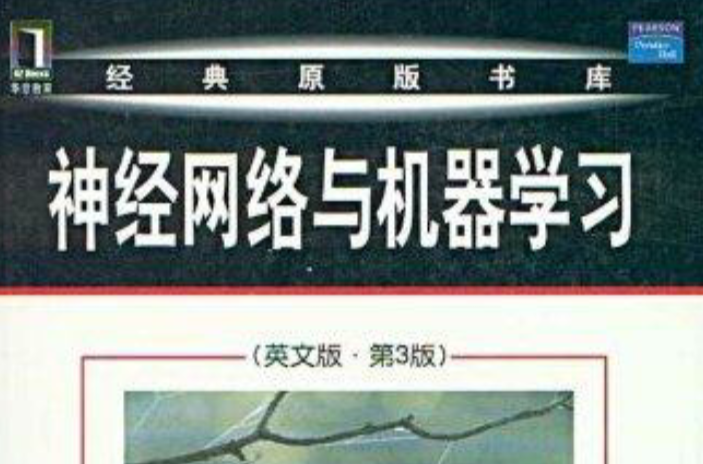《神經網路與機器學習》是2011年3月機械工業出版社出版發行的圖書,作者是Simon Haykin。
基本介紹
- 書名:神經網路與機器學習
- 作者:(加拿大)SimonHaykin
- 原版名稱:Neural Networks and Learning Machines (3rd Edition)
- ISBN:9787111265283
- 定價:69.00元
- 出版社:機械工業出版社
- 出版時間:2009
- 裝幀:平裝
- 開本:16
圖書簡介,內容簡介,作者簡介,編輯推薦,目錄,
圖書簡介
《神經網路與機器學習》由加拿大的SimonHaykin所著,此書結合近年來神經網路和機器學習的最新進展,全面、系統地介紹了神經網路的基本模型、方法和技術,並將神經網路和機器學習有機地結合在一起。
內容簡介
《神經網路與機器學習(英文版第3版)》的可讀性非常強,作者舉重若輕地對神經網路的基本模型和主要學習理論進行了深入探討和分析,通過大量的試驗報告、例題和習題來幫助讀者更好地學習神經網路。神經網路是計算智慧型和機器學習的重要分支,在諸多領域都取得了很大的成功。在眾多神經網路著作中,影響最為廣泛的是SimonHaykin的《神經網路原理》(第4版更名為《神經網路與機器學習》)。《神經網路與機器學習(英文版第3版)》不但注重對數學分析方法和理論的探討,而且也非常關注神經網路在模式識別、信號處理以及控制系統等實際工程問題中的套用。
本版在前一版的基礎上進行了廣泛修訂,提供了神經網路和機器學習這兩個越來越重要的學科的最新分析。
作者簡介
SimonHaykin,於1953年獲得英國伯明罕大學博士學位,目前為加拿大McMaster大學電子與計算機工程系教授、通信研究實驗室主任。他是國際電子電氣工程界的著名學者,曾獲得IEEEMcNaughton金獎。他是加拿大皇家學會院士、IEEE會士,在神經網路、通信、自適應濾波器等領域成果頗豐,著有多部標準教材。
編輯推薦
《神經網路與機器學習(英文版第3版)》特色:
基於隨機梯度下降的線上學習算法;小規模和大規模學習問題。
和方法,包括支持向量機和表達定理。
資訊理論學習模型,包括連線、獨立分量分析(ICA),一致獨立分量分析和信息瓶頸。
隨機動態規劃,包括逼近和神經動態規劃。
逐次狀態估計算法,包括Kalman和粒子濾波器。
利用逐次狀態估計算法訓練遞歸神經網路。
富有洞察力的面向計算機的試驗。
目錄
Preface
Acknowledgements
AbbreviationsandSymbols
GLOSSARY
Introduction
1WhatisaNeuralNetwork?
2TheHumanBrain
3ModelsofaNeuron
4NeuralNetworksViewedAsDircctedGraphs
5Feedback
6NetworkArchitecturns
7 KnowledgeRepresentation
8LearningProcesses
9Learninglbks
10ConcludingRemarks
NotesandRcferences
Chapter1Rosenblatt'sPerceptrou
1.1Introduction
1.2Perceptron
1.31hePcrceptronConvergenceTheorem
1.4RelationBetweenthePerceptronandBayesClassifierforaGaussianEnvironment
1.5ComputerExperiment:PatternClassification
1.6TheBatchPerceptronAlgorithm
1.7SummaryandDiscussion
NotesandRefercnces
Problems
Chapter2ModelBuildingthroughRegression
2.1Introduction68
2.2LinearRegressionModel:PreliminaryConsiderafions
2.3MaximumaPosterioriEstimationoftheParameterVector
2.4RelationshipBetweenRegularizedLeast-SquaresEstimationandMAPEstimation
2.5ComputerExperiment:PatternClassification
2.6TheMinimum.Description-LengthPrinciple
2.7RniteSample—SizeConsiderations
2.8TheInstrumental,variablesMethod
29SummaryandDiscussion
NotesandReferences
Problems
Chapter3TheLeast—Mean-SquareAlgorithm
3.1Introduction
3.2FilteringStructureoftheLMSAlgorithm
3.3Unconstrainedoptimization:aReview
3.4ThCWienerFiIter
3.5neLeast.Mean.SquareAlgorithm
3.6MarkovModelPortrayingtheDeviationoftheLMSAlgorithmfromtheWienerFilter
3.7TheLangevinEquation:CharacterizationofBrownianMotion
3.8Kushner’SDirect.AveragingMethod
3.9StatisticalLMSLearningIheoryforSinailLearning—RateParameter
3.10ComputerExperimentI:LinearPTediction
3.11ComputerExperimentII:PatternClassification
3.12VirtucsandLimitationsoftheLMSAIgorithm
3.13Learning.RateAnnealingSchedules
3.14SummaryandDiscussion
NotesandRefefences
Problems
Chapter4MultilayerPereeptrons
4.1IntroductlOn
4.2SomePreliminaries
4.3BatchLearningandon.LineLearning
4.4TheBack.PropagationAlgorithm
45XORProblem
4.6HeuristicsforMakingtheBack—PropagationAlgorithmPerfoITnBetter
4.7ComputerExperiment:PatternClassification
4.8BackPropagationandDifferentiation
4.9TheHessianandlIsRole1nOn-LineLearning
4.10OptimalAnnealingandAdaptiveControloftheLearningRate
4.11Generalization
4.12ApproximationsofFunctions
4.13Cross.Vjlidation
4.14ComplexityRegularizationandNetworkPruning
4.15VirtuesandLimitationsofBack-PropagationLearning
4.16SupervisedLearningViewedasanOptimizationProblem
4.17COUVOlutionaINetworks
4.18NonlinearFiltering
4.19Small—SealeVerSusLarge+ScaleLearningProblems
4.20SummaryandDiscussion
NotesandRCfcreilces
Problems
Chapter5KernelMethodsandRadial-BasisFunctionNetworks
5.1Intreduction
5.2Cover’STheoremontheSeparabilityofPatterns
5.31heInterpolationProblem
54Radial—Basis—FunctionNetworks
5.5K.McansClustering
5.6RecursiveLeast-SquaresEstimationoftheWeightVector
57HybridLearningProcedureforRBFNetworks
58ComputerExperiment:PatternClassification
5.9InterpretationsoftheGaussianHiddenUnits
5.10KernelRegressionandItsRelationtoRBFNetworks
5.11SummaryandDiscussion
NotesandReferences
Problems
Chapter6SupportVectorMachines
Chapter7RegularizationTheory
Chapter8Prindpal-ComponentsAaalysis
Chapter9Self-OrganizingMaps
Chapter10Information-TheoreticLearningModels
Chapter11StochasticMethodsRootedinStatisticalMechanics
Chapter12DynamicProgramming
Chapter13Neurodynamics
Chapter14BayseianFilteringforStateEstimationofDynamicSystems
Chaptel15DynamlcaayDrivenRecarrentNetworks
Bibliography
Index
……

